Previously, in writing about Pershing Square I neglected to describe the essential role the place had in the Gay history of Los Angeles. This post is an attempt to redress that lack of research and to recognize LGBT month at Los Angeles Public Library.
One must conjure up a picture of the homophobic times to appreciate the importance of the open social spaces in the old park for the severely persecuted men who had to remain secretive about their sexual orientation to protect their livelihoods and freedom. From the post-World War I era up into the 1960’s downtown Los Angeles maintained what was called in the underground gay community “the Run” where gents could stroll, meet like-minded fellows, and feel somewhat comfortable in their own skins. “The Run” encompassed parts of the cocktail lounge at the Biltmore Hotel, places in and around the Central Library, and primarily Pershing Square where trysts and flirtations abounded. Remember that this was a time when homosexuality was equated with the most negative of false stereotypes and the medical establishment described the orientation as “a perversion” or “mental disease.” Police harassment was an official policy and ruthless vice squad members preyed upon these men who risked losses of jobs, social status, and large fines that could ruin them financially and emotionally.
In 1953 Executive Order 10450 made it official that anyone found to be gay could be fired from their jobs with no warning and even business owners who catered to gay clientele could lose their license. Yet, savvy businessmen did provide an escape from the homophobia surrounding this society and places like the discreet “Crown Jewel” or the more “out” Harold’s, the Waldorf and Maxwell’s operated in downtown despite the constant threat of being raided and all the customers being arrested for merely sitting together or dancing. Still, Pershing Square was the place for meeting fellow gays but LAPD was there also, gathering some 10,000 files on suspected “sex offenders.” World War II offered a small oasis for gay men and women who found R&R in downtown despite 30 establishments declared “out of bounds” for servicemen and women. Entrapment was rife and shakedowns common as those cruising “the Run” sought comfort from each other but often found themselves in custody. After arrests, most just kept quiet about the injustice of it all in hopes the truth would not come out. Being closeted was the only choice in these backwards times.


October 1957 edition of The Ladder | ONE Magazine, 1953, Collections of the Smithsonian’s National Museum of American History.
Close by to the Square was Cooper’s Donuts on Main street where in 1959 fed-up men and trans-gendered women fought back at the harassment they were forced to suffer from the police and created a demonstration of defiance (pelting vice cops with donuts and coffee) that predated another such at the “Black Cat” in Silverlake by seven years and the famed Stonewall Riots in New York by a decade. Magazines appeared to finally allow gay people to express their feelings including “One” and the Lesbian newsletter “Vice Versa” and later “the Ladder.” Gay enclaves sprung up around the southland in Long Beach, Bunker Hill, Silverlake, Hollywood, and even the Santa Monica mountains. Still, the stigma remained in mainstream America, and as late as 1964 Life Magazine published a particularly damning article that described the lifestyle as “sad and sordid” without even interviewing the people they were judging so harshly. As the freedoms of the 1960s spread somewhat there were 84 bars, restaurants, and coffee shops catering to gay men and women around Los Angeles including a dozen west of downtown along Sunset Boulevard. The Mattachine Society, the first gay-rights organization had been formed by Harry Hay in the mid-1950s and by 1969 the Gay Liberation Front was operating in the open leading toward a greater understanding of the community. As Gay life spread out focusing on West Hollywood, “the Run” and Pershing Square ceased to be essential but if that square could speak it would have tales to tell.
Downtown Los Angeles, George Coupland Thomas, Thomas Brothers Map Company, 1946.

